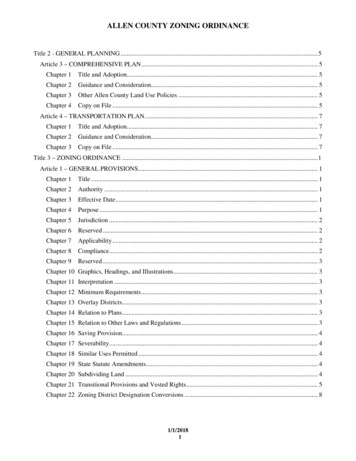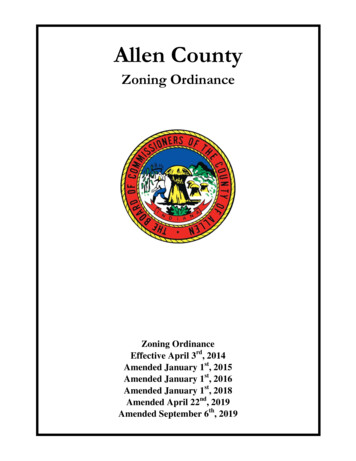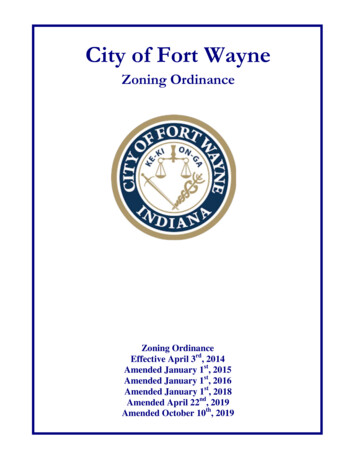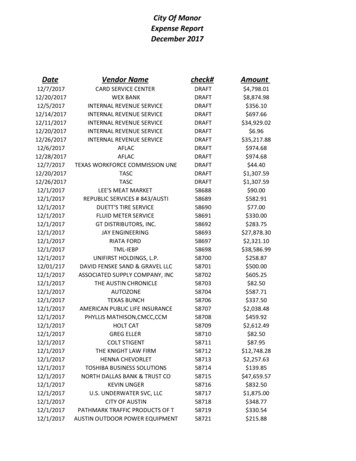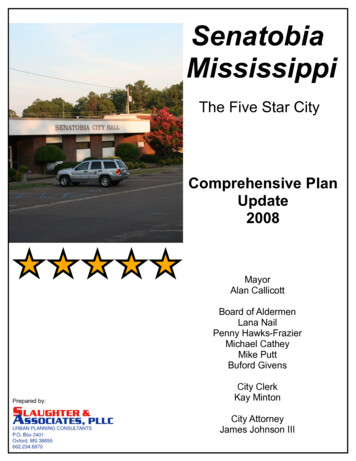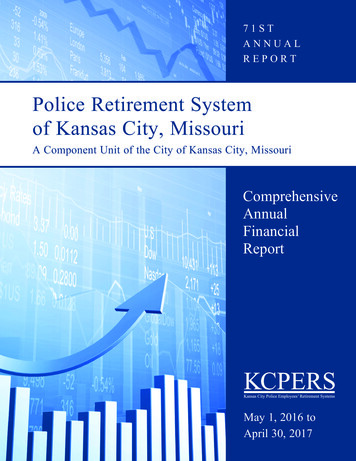
Transcription
COMPREHENSIVE PLAN 2017-2037CITY OF CUMMING, GEORGIAJanuary 2017 2nd DraftFor Public Hearings February 2017
ContentsCity of Cumming, GA, Comprehensive Plan 2017-2037Comprehensive Plan Steering Committee 2016-2017Troy BrumbalowChristopher LightLinda LedbetterJason MayRandy MurphyBrent OtwellRalph WebbCity of Cumming Planning CommissionRalph Webb, ChairmanRandy MurphyBrent OtwellCity of Cumming Mayor and City CouncilH. Ford Gravitt, MayorQuincy HoltonLinda LedbetterLewis LedbetterChristopher LightCharles F. Welch, Jr.City of Cumming Key StaffGerald Blackburn, City AdministratorPhil Higgins, Assistant City AdministratorHugh Boling, Street Department DirectorJonathan Heard, Director, Department of UtilitiesJeff Honea, City ClerkDave Horton, Fairgrounds DirectorCrystal Ledford, Public Information AssistantGreg Little, Recreation and Parks DirectorDana Miles, City AttorneyScott Morgan, Director, Department of Planning and ZoningCasey Tatum, Police ChiefCarla Wilson, Aquatic Center ManagerPrepared Under Contract ByJerry Weitz & Associates, Inc.ii
ContentsCity of Cumming, GA, Comprehensive Plan 2017-2037CONTENTSCHAPTER 1 INTRODUCTION1LOCATION AND ECONOMY1ORGANIZATION1PURPOSES OF PLANNING2PLANNING HISTORY2COMMUNITY PARTICIPATION3FORSYTH COUNTY CONTEXT4Rapid Development and Efforts to Manage GrowthTransportation NeedsIncome and HousingLabor Force, Employment, and CommutingCommunity Facilities45566CHAPTER 2 NEEDS AND OPPORTUNITIES8STRENGTHS8OPPORTUNITIES9WEAKNESSES AND THREATS10CHAPTER 3 LAND USE15LAND USE CATEGORIES15EXISTING LAND USE (2016) AND LAND USE CHANGE (2011-2016)20FUTURE LAND USE (2037) AND FUTURE LAND USE CHANGE (2016-2037)21FUTURE LAND USE PLAN IMPLEMENTATION23CHAPTER 4 TRANSPORTATION25METROPOLITAN TRANSPORTATION PLANNING25COUNTY TRANSPORTATION PLANNING25iii
ContentsCity of Cumming, GA, Comprehensive Plan 2017-2037ROADWAY NETWORK25ALTERNATIVE MODES OF TRANSPORTATION26Sidewalks and Bicycle TransportationPublic Transportation2728RAILROADS, TRUCKING, PORT FACILITIES AND AIRPORTS29TRANSPORTATION AND LAND USE CONNECTIONS29CHAPTER 5 VISION, GOALS AND POLICIES31VISION31NATURAL RESOURCES AND THE ENVIRONMENT32Environmental GoalGeneral Environmental PoliciesFlood Plain and Tributary ProtectionWetlandsWatershed Protection GenerallyBig Creek WatershedBig Creek Ecological Greenway32323333343536HISTORIC PRESERVATION36Historic Preservation GoalHistoric Preservation Policies3637HOUSING37Housing GoalHousing Policies3737ECONOMIC DEVELOPMENT39Economic Development GoalEconomic Development Policies3939LAND USE40Established Single-Family NeighborhoodsMulti-Family Residential DevelopmentCentral Business District (CBD)414142iv
ContentsCity of Cumming, GA, Comprehensive Plan 2017-2037Neighborhood ShoppingHighway Commercial CorridorsPlanned Shopping CentersSuburban Mixed UseOffice DevelopmentInstitutional DistrictsIndustrial DistrictsTransitional NeighborhoodsEnvironmentally Sensitive AreasLand Development Process43434344454546464646COMMUNITY FACILITIES AND SERVICES47Community Facilities GoalGeneral Policy for Siting Community FacilitiesWaterSanitary SewerStormwater ManagementFire Protection/Emergency Medical ServicesPolice DepartmentParks and Recreation/Fairgrounds/Cultural FacilitiesEducationGeneral Government, Planning and AdministrationHealth and hways and RoadsAlternative TransportationOther Transportation Policies525557INTERGOVERNMENTAL COOPERATION58Intergovernmental Cooperation GoalIntergovernmental Cooperation Policies5858CHAPTER 6 COMMUNITY WORK PROGRAM60IMPLEMENTATION RESPONSIBILITIES60SHORT-TERM WORK PROGRAM60LONG-RANGE PLANS65Georgia Mountains Regional CommissionAtlanta Regional Commission6565v
ContentsCity of Cumming, GA, Comprehensive Plan 2017-2037Metropolitan North Georgia Water Planning District66MUNICIPAL LONG RANGE PROJECTS66APPENDIX A: REPORT OF ACCOMPLISHMENTS2012-2016 SHORT-TERM WORK PROGRAM69APPENDIX B: COMMUNITY QUESTIONNAIRE RESULTS73vi
ContentsCity of Cumming, GA, Comprehensive Plan 2017-2037LIST OF TABLESTable 3-1 Description of Land Use Categories, Existing and Future Land Use Maps,City of Cumming17Table 3-2 Building and Density/Intensity Specifications for the Suburban Mixed UseDistrict20Table 3-3 Existing Land Use 2011 and 2016 and Land Use Change, 2011-2016,Cumming City Limits21Table 3-4 Future Land Use 2016 and Future Land Use Change, 2016-2037,Cumming City Limits22Table 3-5 Forecasted Future Development Capacity by Land Use, City of Cumming,2017-203723Table 3-6 Existing (2016) and Forecasted (2037) Housing Units, Households,Population and Employment, City of Cumming23Table 3-7 Future Land Use and Zoning District Consistency24Table 6-1 Community Work Program, 2017 to 2021, City of Cumming61Table 6-2 Long-Range Projects, City of Cumming67LIST OF FIGURES AND MAPSStrengths, Weaknesses, Opportunities, and Threats (SWOT) Summary8Existing Land Use, 201618Future Land Use, 203719The Land Use-Transportation Cycle30vii
CHAPTER 1INTRODUCTIONLOCATION AND ECONOMYThe City of Cumming lies in ForsythCounty, Georgia, in the Atlanta MetropolitanStatistical Area, along the western shorelineof Lake Lanier. Cumming is the onlyincorporated place in Forsyth County.Cumming, as the most densely developedeconomic base in the county, has remainedthe center of trade for the county fordecades. Cumming’s location adjacent toLake Lanier makes it a jumping off point forrecreational activities along the lake,including sightseeing, boating, fishing, andcamping. Tourism dollars are often spent onretail goods, lodging, and food.Buford DamThe city has a well-diversified economic base, one that is especially strong in government, retailtrade, manufacturing, and health care, and that has historically maintained substantial shares oftotal county employment in other industry sectors such as real estate and information. Cumminghas a sizable share of land for expansion of major sectors of the economy. There is considerablevacant acreage for the expansion of retail trade, Class A office space, and services, includinghealth care. Cumming will continue to be a prime location for a wide variety of jobs for skilledlabor, unskilled labor, recent college graduates, and professionals and managers in the county.ORGANIZATIONThis chapter introduces the comprehensive plan, articulates purposes of comprehensive planning,summarizes prior planning efforts, describes the community participation process followed incompleting the plan, and provides other contextual information about Forsyth County.Chapter 2 is the “needs and opportunities” element. Chapter 3 of the comprehensive plandescribes existing land use and provides a future land use plan map (for the year 2037) to guidefuture zoning and development decisions. Chapter 4 addresses transportation. Chapter 5 containsa vision, goals, and policies for all subject matters: natural resources and the environment,housing, economy, land use, community facilities and services, transportation, andintergovernmental cooperation. Chapter 6, provides the city’s community work program for theyears 2017 to 2021 and identifies long-term plans and projects. Two appendices are also a part ofthis document. Appendix A is a report on accomplishments in implementing the city’s previousshort-term work program, 2012-2016. Appendix B is a summary of the community questionnaireresults.1
Chapter 1, IntroductionCity of Cumming, GA, Comprehensive Plan, 2017-2037PURPOSES OF PLANNINGA rationale for land use planning is provided in Chapter 3. Here, the major purposes ofcomprehensive planning are summarized. As noted in the state’s rules for local comprehensiveplanning, comprehensive planning by local governments enhances coordination at many levels,especially relations between the city and host county but also other local, regional, state, andfederal agencies. According to the state rules, the “highest and best use” of comprehensiveplanning for local governments is to show important relationships between community issues.Unless a concerted effort is made to understand interrelationships between various subjectmatters like land use and transportation, the community may remain unaware of how actions inone arena of policy affect another.A comprehensive plan has value in terms of transparency. In adopting a comprehensive plan, thelocal government is offering information on intentions and likely future conditions. The planprovides an “environment of predictability” for businesses, institutions, industries, investors,property owners, and residents. Communities that engage in planning are more likely to be betterprepared to attract new growth in a highly competitive global market. Local planning can helpthe community reinforce its strengths, overcome its weaknesses, capitalize on opportunities, andminimize or mitigate threats.PLANNING HISTORYIn the early 1980s, Cumming operated a joint planning commission and planning departmentwith Forsyth County. However, long ago it decided to provide its own planning and zoningdepartment and to prepare its own comprehensive plan. The City of Cumming has now had along history of comprehensive planning. One of the earliest comprehensive plans was theGeneral Plan for the Year 2015, adopted in 1995. In 2003, the city prepared a newcomprehensive plan which was adopted in 2004, in compliance with rules of the GeorgiaDepartment of Community Affairs (DCA). As a part of the revised zoning ordinance in 2003,Cumming adopted the environmental planning criteria (1990) adopted pursuant to the GeorgiaPlanning Act of 1989. Article X of the zoning ordinance covers groundwater recharge areas,Article XI provides regulations for the Big Creek Water Supply Watershed, and Article XIIprovides regulations for wetlands. In 2009, the City Council adopted a partial plan update incompliance with local planning rules in effect at that time. The city then adopted a newcomprehensive plan prior to its recertification deadline of June 30, 2012. The 2012comprehensive plan consisted of a community participation program, a data-driven communityassessment, and a “community agenda” (i.e., the plan portion of the comprehensive plan).This comprehensive plan (2017-2037) was prepared in accordance with DCA rules that went intoeffect in 2014. The DCA rules in effect and governing this planning effort are much more basicthan those rules in effect at the time the 2012 comprehensive plan was prepared and adopted. Acommunity assessment is no longer required, although local plans are expected to be based onanalysis of data where appropriate. The 2014 DCA rules for local planning emphasize brevity inthe presentation of the plan document itself, and considerable effort to involve the public in theplan making process, especially local elected officials.2
Chapter 1, IntroductionCity of Cumming, GA, Comprehensive Plan, 2017-2037This comprehensive plan (2017-2037) draws extensively from, and retains many contents of, thecity’s comprehensive plan adopted in 2012. The 2012 community agenda and thiscomprehensive plan are similar in many respects; in particular, both planning processes weredriven by needs assessment and issue identification processes in participatory context, and bothplans are organized similarly with chapters on needs and opportunities, goals and policies, andland use.COMMUNITY PARTICIPATIONAs required by DCA rules, a comprehensive plan steering committee was appointed by theMayor and City Council to spearhead the effort. Two elected city council members wereappointed to and actively served on the steering committee. On August 16, 2016, the city heldtwo public hearings (4:00 p.m. and 7:00 p.m.) with members of the appointed comprehensiveplan steering committee present. The steering committee met again September 27, 2016, and thecommittee meeting included a public comment opportunity. The emphasis of that secondmeeting was land use. A third meeting of the appointed steering committee was held in October2016, during which members discussed land use issues and a first draft of the community workprogram. Mayor Ford Gravitt attended the first and third meetings of the steering committee, andthe Mayor as well as those council members not appointed to the steering committee wereinterviewed in stakeholder meetings held in September 2016.Stakeholders (i.e., people with a major stake in outcomes of the planning process) wereidentified in a public process which included input from steering committee members andsuggestions by individual citizens via a community survey. The stakeholders identified wereinterviewed during September 2016 by Scott Morgan, the city’s planning and zoning director,Jerry Weitz, the city’s comprehensive planning consultant, and Crystal Ledford, the city’scommunication coordinator for the plan effort. A list of the 14 stakeholders interviewed isprovided in Appendix B of this comprehensive plan, under Question #1.Cumming’s comprehensive plan process also benefited from a community questionnaire,developed by the planning consultant and made available electronically to the community byCrystal Ledford using Survey Monkey. The survey instrument asked questions, among others,about who were the important stakeholders to interview (100 responses received), what the city’sstrengths, weaknesses, opportunities and threats were, specific questions about annexation,environmental quality, satisfaction with facilities and services provided by the City of Cumming,and what the highest priorities should be for the new comprehensive plan. The results of thequestionnaire are presented in Appendix B of this comprehensive plan.The community participation process concluded in early 2017 with a final meeting of thecomprehensive plan steering committee to review and comment on the complete draft of thecomprehensive plan, and a final public hearing as required by DCA rules.3
Chapter 1, IntroductionCity of Cumming, GA, Comprehensive Plan, 2017-2037FORSYTH COUNTY CONTEXTThis section summarizes information from Forsyth County’s updated comprehensive plan that isrelevant in context to the city. The population estimate for Forsyth County in 2015 is 212,438.The City of Cumming is the only incorporated area in Forsyth County, representing 2.7 percentof the total Forsyth County population as recorded by the 2014 American Community Survey;this is less than the 3 percent of the population that it accounted for in the 2010 Census.Unincorporated Forsyth County has seen disproportionate growth compared to the City ofCumming since 1990, with Cumming dropping from 6.4 percent to 2.7 percent of the totalForsyth County population (County comprehensive plan, Appendix A).Rapid Development and Efforts to Manage GrowthForsyth County is a suburban growth hotspot of metropolitan Atlanta. In 2015 and 2016,development resumed (if not exceeded) the frantic pace which had occurred prior to the greatrecession (2008). As noted in chapter 2 of the county’s comprehensive plan, since 2010,approximately 4,000 acres in the county have been developed.“From 2010 to 2015 there were 14,043 building permitsfor new residential units issued in Forsyth County, inclusiveof the City of Cumming (U.S. Census Bureau BuildingPermit Survey for New Residential Construction). This istwice the rate of permitting as Cherokee County and justbelow the 15,185 permits issued over the same period inGwinnett, a county four times larger than Forsyth”(Forsyth County Comprehensive Plan, Appendix A).Many changes have occurred due to rapid urbanization, including mass grading of land fordevelopment sites, removal of trees, increased stormwater runoff, loss of historic landscapes, andchanges in aesthetics and character. Rapid land development practices have led to considerableangst and discontent among the county’s unincorporated residents, as the county attempts to keepup its level of services for community facilities such as schools, roads, parks, public safety, andcultural facilities. Forsyth County’s residents are legitimately concerned about growth outpacinginfrastructure, and it appears that a sizable segment of them desire to slow the pace ofdevelopment. There are also concerns about the quality and character of new development.Such concerns will continue given the outlook for continued record growth, assuming that theeconomy does not falter. The county’s total population is projected to be 353,518 by 2030, and446,778 by 2040. For 2037, the planning horizon of this Comprehensive Plan update, theprojected total county population based on residential permits is 418,800 (County comprehensiveplan, Appendix A).4
Chapter 1, IntroductionCity of Cumming, GA, Comprehensive Plan, 2017-2037Transportation NeedsMany of the highest-ranking needs identified in the Forsyth County comprehensive plan relate totransportation. There is a need to reduce the punishing levels of traffic congestion with additionalroad capacity and greater efficiencies in the transportation network. Future development needs tobe better connected by roads. There is a lack of appropriate transportation infrastructure in someplaces, especially when traveling east-west. The county’s development pattern is over-reliant onGeorgia Highway 400 for mobility. The single-function, suburban land use pattern ofdevelopment lengthens commute times. There is great interest in expanding transportationchoices by adding sidewalks and bicycle lanes to the existing transportation system. And there isa notable lack of existing public transit options and a need to connect with regional transitservices.Traffic congestion has an important and potentially detrimental relationship to economicdevelopment. As explained in the county’s comprehensive plan (Appendix A), when thetransportation system does not work well, there can be significant economic penalties throughopportunity costs (such as spending too much time in traffic), fuel costs, and businessrelocations.Income and HousingThe median household income in Forsyth County is 85,639. This is significantly higher than allof the other geographies analyzed, with the second-highest recorded as 69,711 in CherokeeCounty, and nearly double that of the State of Georgia at 49,321 (County comprehensive plan,Appendix A).Because of incredible increases in affluence of Forsyth County residents and an emphasis onowner-occupied, large lot, suburban, single-family homes, the county’s housing stock as a wholeis becoming lopsided in terms of housing choice. Indeed, as reported in the county plan, thepercentage of Forsyth’s housing stock that is single family (either detached or attached) isnotably higher than that of Fulton, Gwinnett, and Hall Counties. Renters comprise only 17.6percent of the population. This development trend towards Forsyth County remaining a“bedroom community” is further confirmed when one examines the significant number ofresidential developments constructed between 2010 and 2015. Out of the approximate 4,000acres developed or redeveloped, more than 3,700 acres were developed for detached singlefamily uses (County comprehensive plan, Appendix A).Housing affordability is an increasing issue. Forsyth County demonstrates the highest medianhousing value when compared to Fulton, Gwinnett, Hall, and Cherokee Counties – with anestimated median housing value of 276,800 (County comprehensive plan, Appendix A). Thecounty plan also notes there is a noticeable lack of housing options for persons and householdsearning less than 50,000 a year. Expensive housing in the county has reportedly discouragedone or more corporations from locating in Forsyth County. Indeed, as the County ’s service andretail footprint increases, local employers may find it harder to attract the best employees ifattainable housing is located too far away (County comprehensive plan, Appendix A). There is5
Chapter 1, IntroductionCity of Cumming, GA, Comprehensive Plan, 2017-2037also a lack of senior housing, and the housing market has been slow to anticipate and providehousing options appropriate for an aging population.As family households age into empty nesters, demand for smaller, low- or no-maintenancehomes will increase. Older households may begin to seek age-targeted townhomes, single-storydetached homes, age-restricted communities and even continuing care communities (Countycomprehensive plan, Appendix A).Labor Force, Employment, and CommutingThe unemployment rate for the Forsyth County labor force is reportedly among the lowest in theregion. There were 89,099 Forsyth County residents in the labor force as of 2013. The largestindustries for employment were professional and technology with 10,717 employees (12.0percent of the workforce), retail trade (9,968 workers, 11.2 percent), and manufacturing (8,738workers, 9.8 percent). Major employers in Cumming include Tyson Poultry, Koch Foods,Northside Hospital, and the Forsyth County School System. (County comprehensive plan,Appendix A). It is estimated that 69 percent of people employed in Forsyth County live inanother county, while the remaining 31 percent working in Forsyth County also live in ForsythCounty.Though likely to change soon, Forsyth County is not yet a substantial office market. The largemajority of Class A professional space in the area is located in north Fulton County. There areoffice buildings in and around Cumming, including condominium, executive suites, and smallformat office space serving professional services and medical users. A large concentration ofmedical office building spaces surrounds Northside Hospital-Forsyth in Cumming. The mostintensive concentration of retail trade exists at the Georgia 400 and State Route 20 (BufordHighway) interchange, where more than 1.5 million square feet of community-scale retail isfound in four main shopping centers (County comprehensive plan, Appendix A), some of whichlies immediately outside the Cumming city limits.Community FacilitiesForsyth County public schools serve 44,400 students with 4,500 employees, according to thecounty comprehensive plan. Strong county public school performance is reinforcing ForsythCounty’s desirability as a residential community, and the excellent school system will continueto attract new households from metropolitan Atlanta and from other regions and states. In 2012,the University of North Georgia Cumming campus opened and has since tripled its enrollment,thus helping to fill a need for additional higher education opportunities in Forsyth County(County comprehensive plan, Appendix A).With regard to county law enforcement, the county consolidated the Sheriff’s Office into aheadquarters at the old courthouse and completed construction of the new courthouse anddetention center in Cumming. The new jail facility in downtown Cumming began operations inSeptember 2015 (County comprehensive plan).6
Chapter 1, IntroductionCity of Cumming, GA, Comprehensive Plan, 2017-2037With proceeds from a 100 million parks/recreation and green space general obligation bondwhich passed in 2008, Forsyth County has acquired and developed multiple new parks spaces.Near Cumming, Sawnee Mountain Preserve gained six miles of hiking trails, two picnicpavilions, a playground, restrooms, and additional parking. The county has also completed PhaseIV construction for the Big Creek Greenway and Phase V is under design. When open to thepublic, these two phases of the greenway will add seven miles of new multi-use trail to thegreenway (County comprehensive plan).In 2016, the City of Cumming completed major improvements to its city park facility on PilgrimMill Road, including a new multi-purpose building, parks and recreation department offices, artsand crafts and dance pavilions, and a high-end playground.7
CHAPTER 2NEEDS AND OPPORTUNITIESThe needs and opportunities element includes a description of needs and opportunities the cityhas identified through a public process. Each need or opportunity that the community hasidentified as a priority is followed-up with corresponding implementation measures in theCommunity Work Program (see Chapter 5 of this plan). To identify needs and opportunities, asrecommended by state rules for local comprehensive planning, a SWOT analysis was conducted,based on input from citizens in a questionnaire (see Appendix B of this comprehensive plan).The figure below summarizes that analysis, and additional narrative about selected needs andopportunities follows.Strengths, Weaknesses, Opportunities, and Threats (SWOT) SummarySTRENGTHSCity government leadership and facilities. A strength of the city government is its leadershipin promoting financial progress and stability over time. Another city strength is its excellence inthe delivery of city facilities and services. The community questionnaire was designed to gaugecitizen satisfaction with the city’s community facilities and services generally and individually.Police, utilities (water, sewer, stormwater), parks, and fairgrounds all received very highsatisfaction ratings (see Appendix B of this comprehensive plan). Residents were somewhatsatisfied with city streets, sidewalks and streetscapes, and city buildings and grounds other thanthe fairgrounds. The absence of very high satisfaction levels in those facilities is attributed in partto traffic congestion in the city and the dominance of institutional facilities (e.g., county jail) inthe downtown.8
Chapter 2, Needs and OpportunitiesCity of Cumming, GA, Comprehensive Plan 2017-2037Central location for development and city-owned properties. The local real estate market isprimed for additional investment, given the city’s central location in the county. There has been ahuge increase in affluence countywide.The city owns vacant property that can andwill shape its future, including primecommercial property along Lanier 400parkway. There are also relatively largeblocks of private land that are “greenfield”and available for development. Economicdevelopment in the city and county iscoordinated via the Chamber of Commerce.The community appreciates the businessfriendly posture of the city.Vacant city-owned propertyalong Lanier 400 ParkwayEducational facilities. Forsyth Countyschools are also growing rapidly andinnovating (e.g., Alliance Academy) in thedelivery of education services. Residents,businesses, and city leaders are excited aboutthe presence of the University of NorthGeorgia in Cumming City Hall and at thesatellite campus of the University of NorthGeorgia located off Pilgrim Mill Road inCumming, and the future possibilities thosearrangements will bring.University of North Georgia classroomspace in Cumming City HallOPPORTUNITIESMary Alice Park. This comprehensive plancalls for initiating a master planning processfor Mary Alice Park, a jewel that needs to becultivated. Prior to the great recession (2008),the city was working with a resort hoteldeveloper to produce a recreation-orienteddevelopment at Mary Alice Park. Citizens andofficials of the city are excited about theprospects for leisure-oriented development ofMary Alice Park.Sketch view of Mary Alice Park9
Chapter 2, Needs and OpportunitiesCity of Cumming, GA, Comprehensive Plan 2017-2037The final uses and composition of development within Mary Alice Park will need to bedeveloped with community consensus, including dialogue with Forsyth County government andForsyth County school system officials. Any development of the park is subject to approval bythe U.S. Army Corps of Engineers. It has been suggested that Mary Alice Park could serve as amulti-faceted indoor and outdoor recreation complex, with lodging and supportive accessoryretail and service functions. It has also been suggested that Mary Alice Park may be anappropriate site to develop a sports stadium serving all high schools in the county (rather thanhaving high schools build separate stadiums).Further, in terms of developing Mary AlicePark, the master planning process to beundertaken in the future should focus onproviding additional, multi-modal access to thepark. Options that should be consideredinclude establishing a ferry from Bald RidgeMarina to Mary Alice Park, providing asecondary road/bridge access from the northend of the park to Georgia 400, and a trolleyfor inner-city mobility.Future planning for Mary Alice Park (peninsula incenter of picture) should consider an additionalroad connection on the northwest and also ferryaccess to Bald Ridge Marina.Growth preparedness and development.Cumming aspires to its next level of greatness.The market is primed for additional Class Aoffice space. There is extensive developmentpotential in the Georgia 400 corridor, includingvacant city-owned property along Lanier 400Parkway and private property within theGeorgia 400 corridor.Existing office space in the cityOpportunities exist for substantial office development in Cumming, in the form of smaller, intown office parks and also in multi-story office commercial campuses along Georgia 400 (seeland use chapter).Cumming expects that most of the remaining large tracts of agricultural, vacant or underutilizedland in the city will eventually be developed as master planned, mixed-use communities. Thecity adopted a multi-use (MU) zoning district and has articulated the desire to see mixed usedevelopment with traditional neighborhood development principles occur in the MU district.The city has completed improvements to infrastructure including water and sewer systemexpansions, widening of roads, installation of sidewalks, improvement of parks, development offairgrounds, and installation of pedestrian friendly, attractive streetscapes in the downtown area.10
Chapter 2, Needs and OpportunitiesCity of Cumming, GA, Comprehensive Plan 2017-2037The city will continue to stay abreast of the service needs imposed on its infrastructure by rapidgrowth in the city and its service area.University of North Georgia campus. Thecity looks forward to collaborating withUniversity of North Georgia in thedevelopment and expansion of its univ
City of Cumming, GA, Comprehensive Plan 2017-2037 iv ROADWAY NETWORK 25 ALTERNATIVE MODES OF TRANSPORTATION 26 Sidewalks and Bicycle Transportation 27 Public Transportation 28 RAILROADS, TRUCKING, PORT FACILITIES AND AIRPORTS 29 TRANSPORTATION AND LAND USE CONNECTIONS 29 CHAPTER 5 VISION, GOALS AND POLICIES 31 VISION 31

